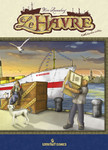Useless Bits Should Not Have Been Produced
I love setting up and taking down board games with lots of bits. Especially wooden bits. Houses. Little men. Meeples. Disks. Cubes. Thick cardboard chits are almost as good. Can you tell I like Euro board games?
But I don’t understand why, when production costs are already normally pretty high, some makers add in pieces that are really not needed – nearly useless bits.
Let me give you three examples:
- Thurn & Taxis
- The Pillars of the Earth
- Le Havre
If you’ve played these fun games, you probably can guess which bits I mean.
Thurn & Taxis Colored Cards

If it weren’t for the colorful houses (stations), Thurn & Taxis would be brown and beige-ish. Each player is identified by the color of his houses – red, blue, yellow, or green.
To help players identify each other throughout the course of the game, the makers included four cards each of which matches the color of one of the houses – sort of. The cards are actually about 99% brown and beige-ish with a thin ribbon of red or blue or yellow or green around the border.
Does it make you want to say, “Huh?”
Well, it made me say, “Huh?”
If I want to see who’s playing which color, I just look over to see their pile of unplayed houses. Those thick, wooden bits that they’ve probably arranged in a pretty pattern or stacked up like a Jenga tower or constructed a mini Rube Goldberg machine out of.
We don’t use the player ID cards.
The Pillars of the Earth Cathedral

I think The Pillars of the Earth was the first game I played where I discovered some nearly useless bits.
This game has a beautiful board which, even today, I don’t think I’ve examined every section of to find all the interesting details that the artist, Michael Menzel, included.
Wooden bits are wonderful, and this game has plenty of them in the form of colored cubes (brown, gray, tan, and blue) and colorful workers and builders (red, blue, yellow, green, gray, and black). But it also wastes at least as much wood in a six-piece cathedral which you are supposed to piece together one bit at a time at the end of each round, theoretically to remind the players which round it is.
In addition, you’re supposed to build this thing in the middle of the board where it can easily be knocked around as players reach for the 14 stations that make up the playing field to either deposit men or pick up goods.
Does that make you want to say, “Really?”
Well, it made me say, “Really?”
It maybe wouldn’t seem so totally useless if the six pieces were painted, but they were left in their native blonde wood color. Would it have cost too much to paint them?
A much better round counter is the stack of cards with big numbers – 1 through 6 – on their backs that need to sit near the edge of the board where everyone can see them easily.
We don’t use the cathedral.
Le Havre’s Start Player Disk

We love playing Le Havre. It’s another game with many, many bits – mostly cardboard chits in this one. In fact, there are so many that we wish the makers would have included something to keep them in like these buckets.
The one item they didn’t really need to spend time on is the start player disk. It just another circle of cardboard with a ship’s wheel on one side and an “old salt” on the other.
There are several other ways to determine who the start player is, or was, and whose turn it is next. Once the game has started, you really don’t ever need to know who made the very first move. After the first round, the start player changes anyway.
Related to this, the numbers on the ship cards that are supposed to help you figure out who does start the next round are pretty useless too. It’s really obvious who goes next from the order of the wooden ship tokens along the supply track.
Does that make you want to say, “Hmm.”
Well, it made me say, “Hmm.”
I can’t say we don’t use the start player circle. We do set it on the table next to the start player, but no one ever looks at it once the game is under way.
And we have no choice but to use the ship cards with those superfluous numbers. Actually, if you would determine the next player according to the description in the official rules, you would need those numbers. However, the rules presume that you’re going to remove the player markers from the board at the end of each round, which is a silly thing to do.
The markers don’t get in the way of the player who will start the next round, so we just leave them where they are at the end of a round. That make it obvious who is to start the next round, and we can thus ignore the numbers on those cards.
